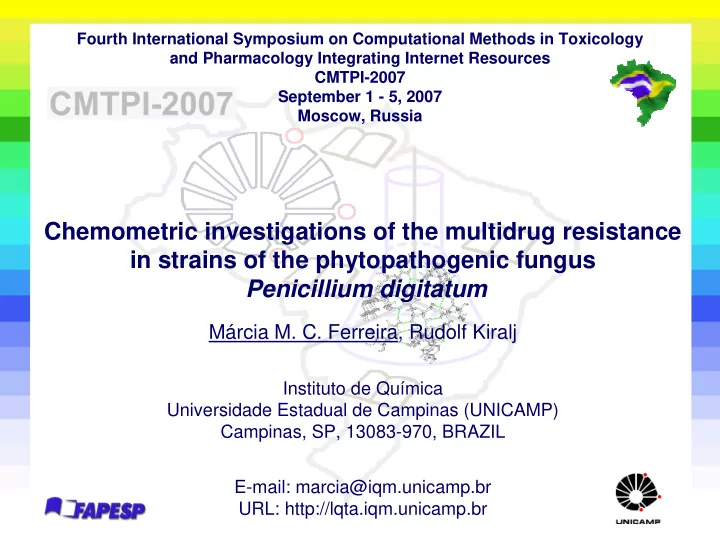

Fourth International Symposium on Computational Methods in Toxicology and Pharmacology Integrating Internet Resources CMTPI-2007 September 1 - 5, 2007 Moscow, Russia Chemometric investigations of the multidrug resistance in strains of the phytopathogenic fungus Penicillium digitatum Márcia M. C. Ferreira, Rudolf Kiralj Instituto de Química Universidade Estadual de Campinas (UNICAMP) Campinas, SP, 13083-970, BRAZIL E-mail: marcia@iqm.unicamp.br URL: http://lqta.iqm.unicamp.br
OUTLINE INTRODUCTION GOAL STUDIED TOXICANTS EXPERIMENTAL DATA DATA SETS DATA SET A: PCA ANALYSIS DATA SET B: HCA AND PCA ANALYSES DATA SET B: PLS REGRESSION DATA SET C: PLS REGRESSION CONCLUSIONS
INTRODUCTION Penicillium digitatum or the green mold: a cause of serious problems in agriculture and even in medicine (immunocompromized patients). P. digitatum under microscope. The brush-like heads (Lat. penicillus = brush ) have finger-like The most frequent targets of P. shape (Lat. digitatum = fingered) at digitatum are fruits, especially their spore-producing ends. citric fruits.
GOAL To propose novel chemometric approaches which can improve the use of bioassays data: identification and characterization of P. digitatum strains before applying adequate pesticides. Literature data were used, with transformations when necessary. The present work is contained in the following publications: -R. Kiralj, M. M. C. Ferreira, QSAR Comb. Sci. , online since 17/07/2007 -M. M C. Ferreira, R. Kiralj, SAR QSAR Environ. Res. , submitted.
Demethylation inhibitors (DMIs): I - IV DNA intercalators: VI and VII STUDIED TOXICANTS Antibiotic: V
EXPERIMENTAL DATA: RADIAL GROWTH DATA P. digitatum colonies (1 strain = 1 colony): -left: free growth -right: inhibited growth (Source: Hamamoto et al., Pest Manag. Sci. 57 (2001) 839-843. Dose-response curves: -no inhibition ( C 0 ) -50% inhibition (EC 50 , Effective Concentration) -100% inhibition (MIC, Minimal Inhibitory Concentration)
DATA SETS A: pECr 50 values. EC 50 transformed into pEC 50 = -log(EC 50 /mol dm -3 ) and then into pECr 50 = pEC 50 /pEC 50 (PD5) where PD5 is the standard strain. Matrix X (6x7), rows: strains, columns: toxicants B: 8 Morphological descriptors of fungal colonies (35 strains): based on radii, circumferences and surface areas of the colonies from free growth and inhibited growth. Matrix X (35,8), rows: strains, columns: descriptors. Dependent variable y : a genome descriptor PCR related to fungal resistance (production of the CYP51 protein). C: 8 selected descriptors from a set of 6 genome descriptors related to fungal resistance (production of proteins CYP51 and PMR1) and 12 products of these descriptors with two molecular descriptors of toxicants. Matrix X (86,8), rows: strain-toxicant-experiment combinations, columns: selected descriptors. Dependent variable y: pEC 50 values.
DATA SET A: PCA ANALYSIS P. digitatum strains: -resistant (DMI-R) -moderately resistant (DMI-M) -sensitive (DMI-S) with respect to DMIs Principal component analysis: -autoscalled matrix X (6x7) -PC1&PC2: 85% total variance PC1-PC2 loadings plot. Strains characterization: -resistance along PC1: sensitive (DMI-S) are left and resistant (DMI-R &DMI-M) right to the dashed line; -diagonal curve: origin - Japanese and non-Japanese strains are separated; target fruits - mandarine molds and other molds are also separated.
DATA SET B: HCA AND PCA ANALYSES Hierarchical cluster analysis: -autoscalled matrix X (35x8) -complete linkage Clustering patterns: -two clusters distinguishing sensitive (DMI-S) from resistant (DMI-R)&DMI-M) strains; -two sub-clusters in each cluster: more round colonies (lower ellipticity) and more elongated colonies (higher ellipticity) when not treated with toxicants Solid squares: external validation set for PLS
Principal component analysis: -autoscalled matrix X (35x8); -PC1&PC2&PC3: 99% total variance. Two cluster observed as in HCA, which distinguish reasonably well: -resistance � resistant (DMIR&DMI-M) from sensitive (DMI-S) strains; -origin � non-Japanese from Japanese&unknown strains; -target fruits � lemon molds from mandarin&unknown molds.
DATA SET B: PLS REGRESSION (35 samples=strains) DATA SET B: PLS REGRESSION The y variable: PCR – a genome variable The model’s basic statistics: 2 PCs (97.6%) Leave-one-out crossvalidation: SEV = 0.028, Q 2 = 0.991 Prediction: Mean Q 2 is high. SEP = 0.023, R 2 = 0.985 Relative errors: -mean: 4.1% -max.: 21.6% (DMI-M) -samples with >10%: 1 External validation (8 samples in external validation set): SEV = 0.030, SEP = 0.025 No chance correlation. Q 2 = 0.982 , R 2 = 0.990
DATA SET C: PLS REGRESSION (86 samples, 22 strains) The y variable: pEC 50 – inhibited radial growth The model’s basic statistics: 5 PCs (96.8%) Leave-one-out crossvalidation: SEV = 0.286, Q 2 = 0.851 Mean Q 2 is high. Prediction: SEP = 0.271, R 2 = 0.874 Relative errors: -mean: 3.3% -max.: 13.3% -samples with >10%: 2 External validation: SEV = 0.305, SEP = 0.279 Q 2 = 0.841 , R 2 = 0.881 No chance correlation.
CONCLUSIONS Presented chemometric approaches to fungal growth data (EC 50 and morphological data) are novel and promising procedures to identify and characterize P. digitatum strains in terms of their resistance to demethylation inhibitors, origin and target fruits. Presented PLS regression models show direct quantitative relationships between genome structure related to the fungal resistance and the fungal growth data. By other words, P. digitatum strains can be well characterized knowing only one of the two types of data.
Recommend
More recommend